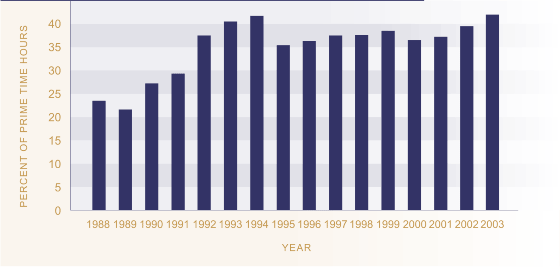Relevance
Television is the dominant cultural medium for most New Zealanders. The 1998/1999 Time Use Survey indicated that New Zealanders spend almost two hours per day watching television or videos.68 Ninety-eight percent of New Zealand households have at least one television set.69 For many people, television is a major source of news, information and entertainment and strongly influences their sense of local and national identity. A local content measure reflects the extent to which we see our culture reflected through this medium.
Current Level And Trends
In 2003, local content on the three main television channels comprised 42 percent of the prime time schedule, an increase from 40 percent in 2002. The proportion of local content rose from 24 percent in 1988 to a peak of 42 percent in 1994, before dropping to 35 percent in 1995.
The percentage of local content in prime time transmission hours differs across the three main channels: TVOne: 60 percent (57 percent in 2002), TV2: 25 percent (20 percent in 2002), and TV3: 41 percent (41 percent in 2002).
Figure CI1.1 Proportion of local
content on prime time television, 1988-2003

Source: New Zealand on Air
(2004)
Note: These figures are for prime time (6pm-10pm) local content on TV
One, TV2, and TV3 only
Since 1988, other free-to-air broadcasters (including Prime, a number of regional channels and the Māori Television Service) as well as pay-television channels Sky (satellite) and Saturn (cable), have joined the three national television channels.
Table CI1.1 Percentage share of prime time local content by programme type, selected years, 1988-2003
| Programme Type | 1988 | 1990 | 1995 | 2000 | 2001 | 2002 | 2003 |
|---|---|---|---|---|---|---|---|
% |
% |
% |
% |
% |
% |
% |
|
| News, current affairs | 26 | 23 | 21 | 30 | 33 | 29 | 32 |
| Information | 10 | 5 | 8 | 17 | 21 | 18 | 19 |
| Sports | 24 | 39 | 31 | 20 | 13 | 18 | 14 |
| Entertainment | 14 | 12 | 9 | 7 | 9 | 10 | 8 |
| Children's | 15 | 13 | 15 | 10 | 8 | 8 | 10 |
| Drama/comedy | 2 | 1 | 7 | 6 | 6 | 6 | 6 |
| Māori | 6 | 3 | 3 | 6 | 6 | 5 | 6 |
| Documentaries | 2 | 3 | 5 | 4 | 4 | 5 | 5 |
| Children's drama | 1 | 1 | 1 | 0 | 0 | 0 | 0 |
| Total New Zealand content hours | 2,112 | 4,249 | 5,018 | 6,185 | 6,190 | 7,201 | 6,526 |
Source: NZ On Air (2000) Appendix 3, p29; (2003) Figure 2, p8
Three programme types accounted for two-thirds of local content hours in 2003: news and current affairs (32 percent), information programmes (19 percent), and sports (14 percent). Hours of prime time sports content fell by 29 percent between 2002 and 2003, largely because in 2002, large sports events such as the Winter Olympics, the Commonwealth Games and the Louis Vuitton Cup were broadcast on prime time television.
International Comparison
International comparisons are difficult due to inconsistencies in measurement approaches by different countries. Available figures suggest that, while local content on New Zealand television is steadily increasing, in 1999 it accounted for 24 percent of total transmission time, and NZ had the smallest proportion of local content. This was compared to USA (90 percent), UK (BBC only, 78 percent), Canada (60 percent), Norway (56 percent), Finland (55 percent), Australia (which mandates a local content transmission quota of 55 percent on all free-to-air commercial networks) and Ireland (RTE only, 41 percent).70 Note that this is a measure of total air time programming, rather than prime time programming, which is the measure the indicator in this report is based on.
